Inexpensive Lift Repair Near Me: Professional Service Technicians at Your Solution
Inexpensive Lift Repair Near Me: Professional Service Technicians at Your Solution
Blog Article
Exploring the World of Lifts: Typical Problems Faced by Numerous Lift Mechanisms
As we navigate via the vertical transport systems of modern-day buildings, elevators stand out as an essential part of our everyday lives. From hydraulic elevators to traction systems and machine-room-less styles, each lift kind comes with its set of typical problems.
Hydraulic Elevators
Hydraulic lifts, frequently chosen for low-rise structures, make use of fluid stress to control the motion of the lift car (lift repair companies). This system includes a hydraulic pump pressing oil right into a cyndrical tube, creating the elevator to relocate the preferred direction. While hydraulic lifts are recognized for their quiet and smooth procedure, they do include their own collection of common issues
One prevalent problem with hydraulic lifts is oil leak. Furthermore, problems with the control system, such as defective valves or a malfunctioning pump, can create disturbances in the lift's motion.
Regular maintenance and punctual fixings are essential to ensure the smooth performance of hydraulic lifts. By resolving these usual problems proactively, building proprietors can minimize downtime and ensure the safety and security and effectiveness of their vertical transportation system.
Traction Lifts
When thinking about vertical transportation systems in buildings, an additional typical type apart from hydraulic lifts is the traction lift. Grip elevators run using a system of ropes and weights that move the lift auto by gripping onto the hoist ropes. This device enables for smoother and faster upright transportation contrasted to hydraulic systems.
One of the typical issues dealt with by traction lifts is rope wear. The constant activity of the ropes within the traction system can cause tear and put on in time, possibly causing the lift to breakdown or become harmful for use. Normal evaluations and upkeep of the ropes are important to ensure the elevator's correct performance and safety.
One more concern that traction elevators might run into is associated to the control system. Troubles with the control system can bring about issues such as unpredictable activity, hold-ups in response times, or perhaps total closures. Normal testing and maintenance of the control system are vital to avoid such problems and ensure the elevator's dependability.
Machine-Room-Less (MRL) Lifts

Among the essential components of MRL lifts is the portable gearless traction maker that is installed within the hoistway. This maker effectively drives the elevator cars and truck without the demand for large equipment located in conventional grip elevators. In addition, MRL lifts normally use a weight system to balance the car, additional boosting their power performance.
Regardless of their advantages, MRL lifts may deal with difficulties connected to maintenance and repair work as a result of the restricted area for tools installation. Accessibility for servicing elements within the shaft can be limited, needing specialized training for service technicians. Proper upkeep routines and normal examinations are essential to make sure the continued smooth procedure of MRL elevators.
Overloading and Weight Limit Issues
Are lifts outfitted to handle excess weight lots effectively and securely? Overwhelming and weight restriction problems are vital problems in elevator operations. Lift producers style lifts with specific weight capabilities to ensure guest safety and security and devices long life. Exceeding these weight restrictions can result in different problems, consisting of mechanical failings, delays, and safety dangers.
When elevators are overloaded, it places too much pressure on the motor, cables, and various other components, possibly causing break downs or malfunctions. If they find excess weight, safety mechanisms such as sensing units and overload sensing units are in area to prevent lifts from moving. In addition, going beyond weight limits can lead to boosted power intake and deterioration on the lift system.
To alleviate straining problems, developing managers must plainly present weight limits in elevators and educate occupants on the importance of sticking to these constraints - lift repair companies. Normal upkeep checks by qualified professionals can also aid guarantee that elevators are operating within risk-free weight specifications. By resolving overloading and weight limit issues proactively, building proprietors can improve lift security and effectiveness
Electrical System Failures
Going beyond weight limitations in elevators can not only lead to mechanical issues but also possibly add to electrical system failings within the lift facilities. Electrical system failures are a critical concern in elevator operation, as they can cause unexpected shutdowns, malfunctions, or even safety and security dangers.
Regular upkeep and examinations are critical to determine and address prospective electrical concerns quickly, making sure the reliable and risk-free operation of lift systems. By sticking to weight limitations and conducting regular electrical system checks, structure owners can alleviate the danger of electrical failures in lifts.
Conclusion

Hydraulic elevators, usually favored for low-rise buildings, use fluid stress to manage the movement of the elevator automobile.When thinking about upright transportation systems in buildings, an additional common type aside from hydraulic lifts is the traction elevator. Grip lifts operate using a system of ropes and counterweights that relocate the lift auto by gripping onto the hoist ropes. Unlike standard lifts that call for a different maker room to house the equipment, MRL elevators incorporate most of the elements within the shaft, eliminating the need for a specialized equipment room.In final thought, lifts encounter common issues such as hydraulic malfunctions, traction system failings, and electric system troubles.
Report this page